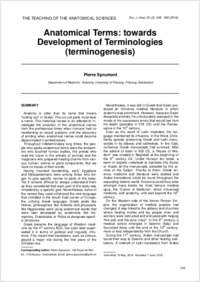Anatomical terms: towards development of terminologies (terminogenesis)
- Sprumont, Pierre Department of Medicine - Anatomy, University of Fribourg, Switzerland
-
2016
Published in:
- European Journal of Anatomy. - 2016, vol. 20, no. 3, p. 249-280
English
Anatomy is older than its name that means "cutting out" in Greek. The cut out parts must bear a name. This historical review is an attempt to investigate the evolution of the anatomical names from the prehistorical times when humans had no handwriting to record anatomy until the discovery of printing when anatomical names could become disseminated in printed books.Throughout indeterminately long times, the people who spoke anatomical terms were the embalmers who touched human bodies, the priests who read the future in the entrails of animals and the magicians who prepared healing charms from various human, animal or plant components. But we have no traces of their words.Having invented handwriting, early Egyptians and Mesopotamians were among those who began to give specific names to parts of the body. Yet it remains difficult to always understand them as they considered that each part of the body was inhabited by a specific god. Nevertheless, some of the names they used influenced the new language that unfolded in the South East corner of Europe, the unifying Greek language. Greek poets like Homer, philosophers like Aristotle and physicians like Hippocrates were using anatomical words that were later developed by anatomists like Herophilos, Erasistratos or Rufos to designate specific structures.Greek became the language of Western medicine by the 4th century BCE, but Latin later superseded it in terms of political and linguistic influence. This meant that translators, such as Celsus, played a major role during the first years of the Christian era.Nevertheless, it was still in Greek that Galen produced an immense medical literature in which anatomy was prominent. However, because Galen dissected animals, he unfortunately stamped in the minds of his successors errors that would last from his death (probably in 216 CE) until the Renaissance in the 15th century.Even as the world of Latin imploded, the language maintained its influence. In the West, Christianity spread, preserving Greek and Latin manuscripts in its abbeys and cathedrals. In the East, numerous Greek manuscripts had survived. After the advent of Islam in 622 CE, a "House of Wisdom" was created in Baghdad at the beginning of the 9th century CE. Under Hunayn ibn Ishak, a team of experts undertook to translate into Syriac or Arabic all the manuscripts collected by the armies of the Caliph. Thanks to them, Greek science, medicine and literature were studied and Arabic translations could be found throughout the expanding Islamic world. Avicenna could thus write amongst many books his most famous medical opus, the "Canon of Medicine", which influenced medicine, and anatomy, until well beyond the 16th century.On the Western side of the former Roman Empire, the organisation of medical practice had changed. It was linked to the abbeys and churches where healing monks and lay people (men and women) were instructed and entrusted with helping "the sick and the poor ones". In the 9th century, a medical school emerged in Salerno (Italy) and flourished there until the end of the 13th century, more or less independently from the Church.During the 11th century, Arabic manuscripts had found their way to Salerno and other healing institutions. A network of Latin translators from Arabic permitted the Western World to re-access the ancient literatures, the School of Toledo (Spain) becoming in the 12th and 13th centuries the most important European centre of translation. Anatomy also re-emerged in Italy at the same time thanks to two types of institutions: the School of Salerno and the universities gradually founded since 1088 (Bologna). Whereas barber-surgeons, surgeons and master-surgeons often came from Salerno, medical doctors came from such Universities as Padua, Bologna and Siena, Oxford, Paris or Salamanca. Trained surgeons attended Universities to deepen their knowledge.In 1315, Mondino de Liuzzi, Professor of Anatomy at the University of Bologna, inaugurated the teaching of human anatomy based upon the dissection of cadavers. The doors now opened to the re-discovery of anatomy, and especially of the internal organs. But Mondino still stuck to the doctrines of the “infallible” masters, although he had written (still in Latin) a book on dissection that remained a classic for two centuries.Some surgeons who had benefited from both an apprenticeship and a Humanist education wrote books in which they finally dared to contradict the old masters. The time was ripe for the arrival of Vesalius.
- Faculty
- Faculté des sciences et de médecine
- Department
- Département de Médecine
- Language
-
- English
- Classification
- Medicine
- Other electronic version
- License
-
License undefined
- Identifiers
-
- RERO DOC 306915
- Persistent URL
- https://folia.unifr.ch/unifr/documents/306251
Other files
Statistics
Document views: 438
File downloads:
- pdf: 1150
- Head to head discussion: 182

